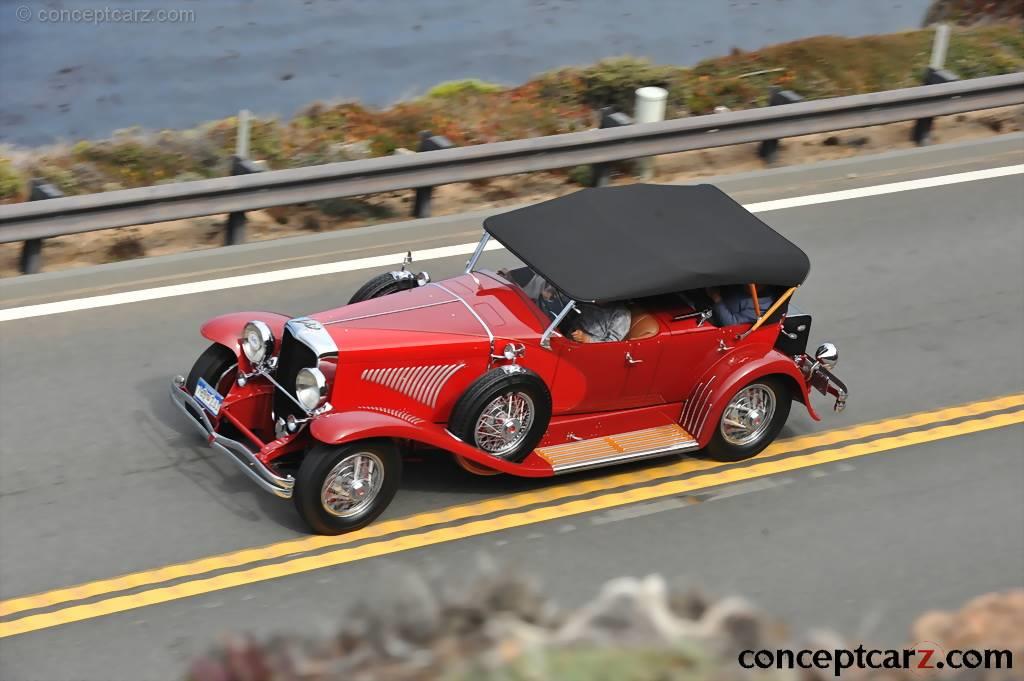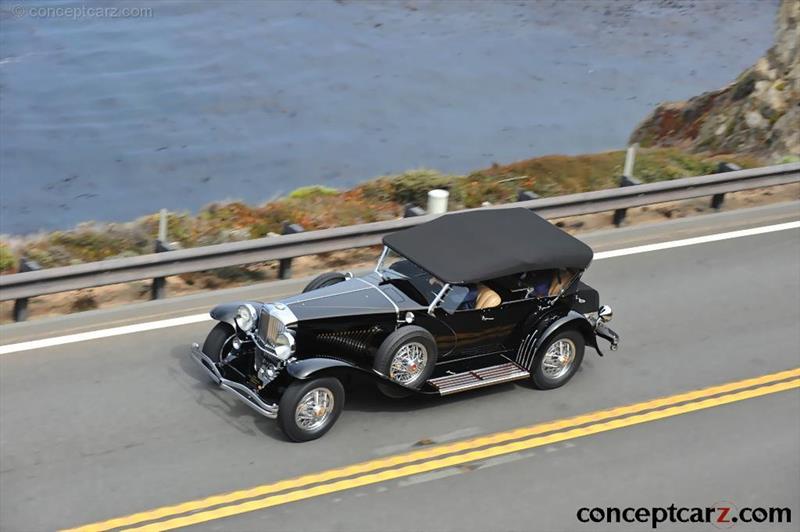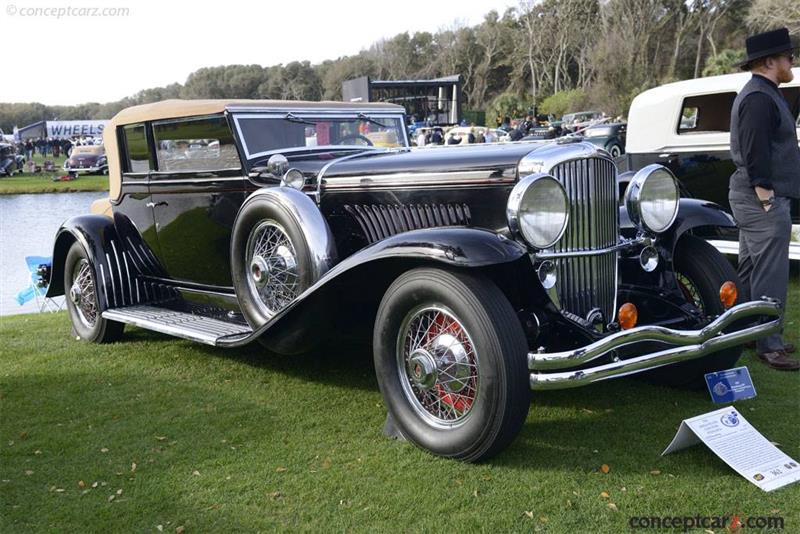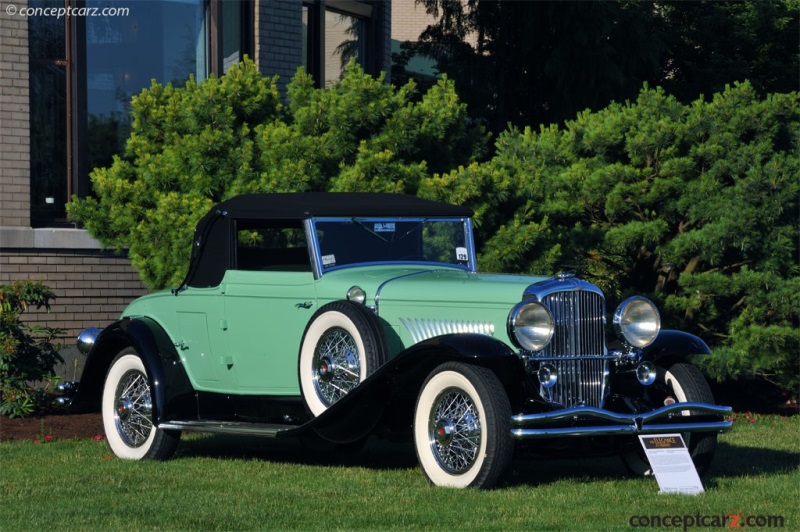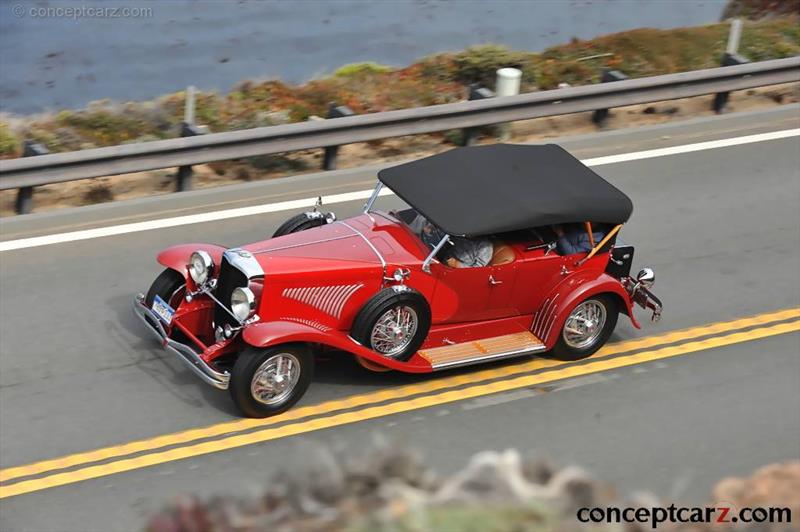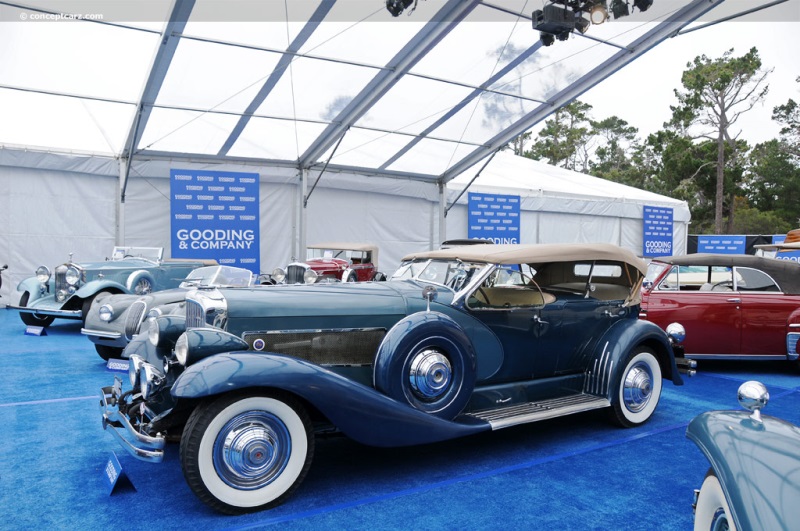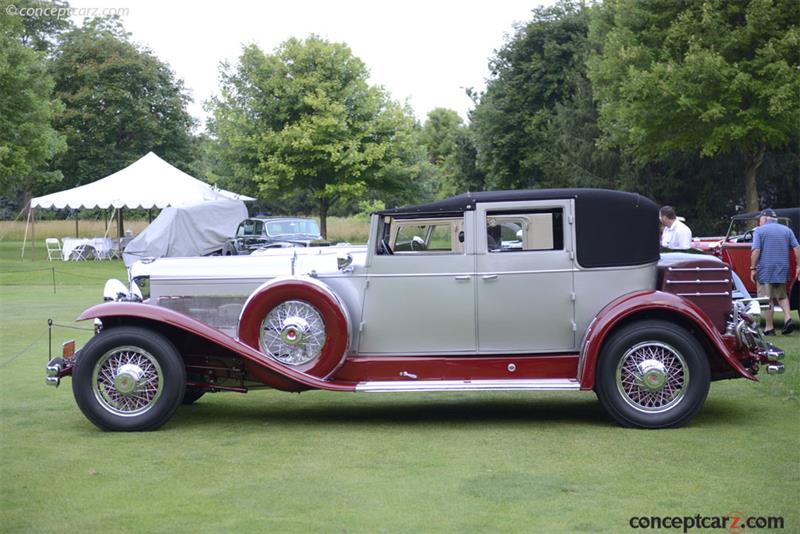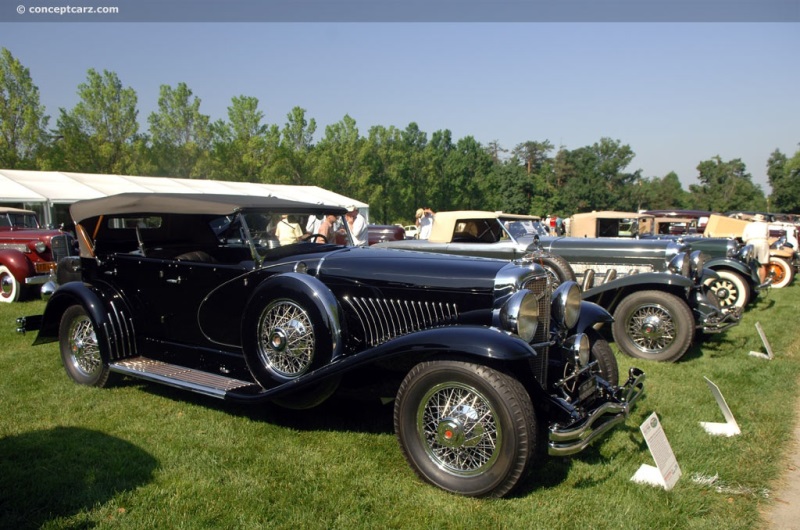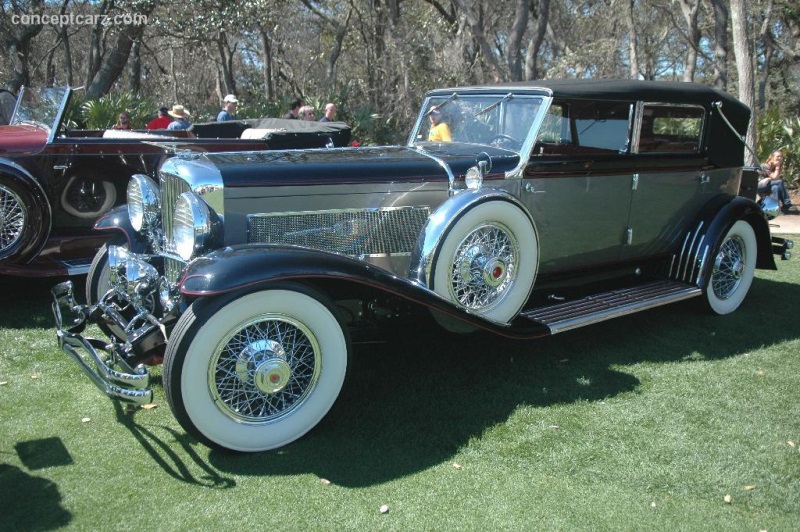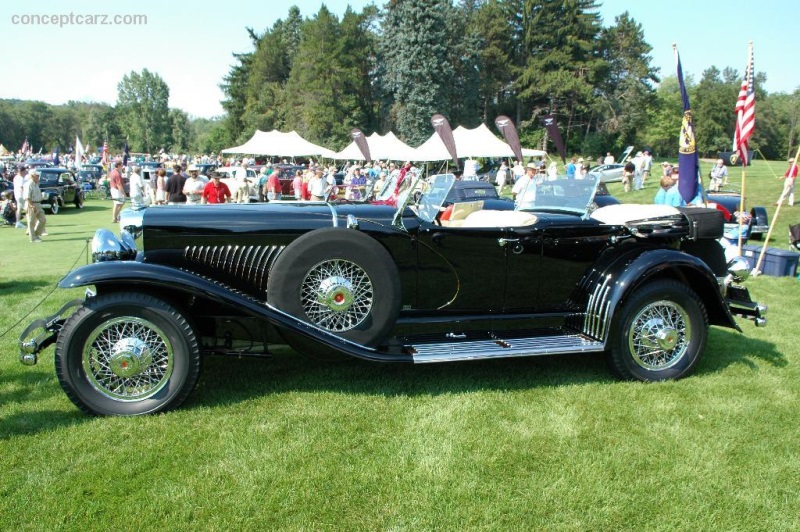1929 Duesenberg Model J Navigation
While the onset of the Great Depression and the Stock Market Crash in 1929 brought the economy to new 'lows,' the introduction of the Duesenberg Model J and the Cadillac V16 introduced new levels of greatness for the entire automotive industry. Although the Cadillac had twice as many cylinders, the Duesenberg - without question - was the ultimate luxury automobile of its day. The 7.4-liter V16 engine from Cadillac delivered 175 horsepower, while the 6.9-liter straight-eight Duesenberg engine offered 265 horsepower, nearly 100 more horsepower from half as many cylinders. Both wore impressive coachwork, and had outstanding proportions, beautiful details, and a presence that evoked power, prestige, and luxury.
The Duesenberg Model J was the brainchild of industrialist E.L. Cord and the crown jewel in his vast business empire. It was an engineering marvel and represented the optimism and enthusiasm for a prosperous economy inspired by the Roaring Twenties. Unveiled at the 1929 New York Auto Salon, the Duesenberg catered to the elite in society, with its exclusivity guaranteed by its steep price tag, often reaching $20,000 when fully clothed with coachwork. This was an astronomical sum considering that most motorists were fortunate to own a $500 Ford Model A. The Duesenberg Model J chassis initially cost $8,500, increasing to $9,500 after 1932. Many of the completed Model Js were priced between $13,000 and $19,000. Two American-bodied Model J's reached $25,000.
Specifications
The Duesenberg Model J was offered with either a 'short' 142.5-inch wheelbase chassis or a 'long' 153.5-inch wheelbase platform. Two special SSJs received a shortened 125-inch wheelbase and a few examples measured 160 inches or more. The chassis used a simple design featuring a ladder frame with six cross-members for added rigidity. An advanced lubrication system automatically started lubricating chassis parts after sixty to eighty miles. Drivers were notified of the lubrication progress by two lights on the dashboard. Two additional lights lit up at 750 and 1500 miles alerting that an oil change and battery check were required. Most chassis and engines were produced in 1929 and 1930 but sold throughout subsequent years. The year associated with each Model J usually represents the year of completion.
The Model J used a beam-type front axle and a live rear axle with semi-elliptic leaf springs. The stopping power was supplied by vacuum-assisted four-wheel hydraulic drums. The engine was designed by Fred Duesenberg and constructed by engine-builder Lycoming, which had recently been acquired by E.L. Cord. It had a cast-iron block and head, a Schebler carburetor, a 5.2:1 compression ratio, double overhead camshafts, and 32 valves. The 265 horsepower produced was sent to the rear wheels via a Warner Gear three-speed manual transmission. A supercharged was introduced in May of 1932 and an example so-equipped was known as the Model SJ (supercharged Model J). The addition of the supercharger increased horsepower to 320 horsepower, reinforcing the company's marketing slogan that 'The only car that could pass a Duesenberg was another Duesenberg—and that was with the first owner's consent.'
Mechanical changes were made throughout the production lifespan of the Duesenberg (although most of the production had occurred in the early years), the list includes the replacement of the four-speed gearbox with an unsynchronised three-speed gearbox which was better suited to cope with the horsepower produced by the engine.
Coachbuilders
The Duesenberg was offered in a vast array of body styles, from two-passenger roadsters to formal limousines. Approximately half of the Model Js built were designed by the company's chief body designer, Gordon Buehrig, and executed under the name La Grande by company branches in New York City, Philadelphia, Chicago, Los Angeles, Denver, and Florida, along with smaller dealerships. The remaining examples were designed and built by independent coachbuilders. Nearly all the great coachbuilders of the era built bodies for the Model J, with the Walter M. Murphy Company of Pasadena, California responsible for the most - at least 125 bodies. LeBaron, Murphy, and Holbrook were selected to build bodies for the first Model Js, which were displayed at the model's 1929 debut in New York. Blueprints of the forth-coming car had been sent to these coachbuilders six months prior to the New York Show.
The Duesenberg Model J enjoyed an enthusiastic welcome upon its introduction at the New York Auto Show, but due to the onset of the Great Depression, sales were dismal. Duesenberg had estimated that 500 examples would be produced each year, but that figure was never achieved. The company had built approximately 200 cars by the start of the Great Depression in October of 1929, and another 100 orders were filled the following year. Total Model J production was 470 units. Ten examples were Model JNs with coachwork by Rollston. Two examples were Model SSJs (short-wheelbase supercharged J) and both wore lightweight open-roadster coachwork by Central Manufacturing Company. One example was a Duesenberg Special known as the Mormon Meteor which had been commissioned by Ab Jenkins. 36 examples were SJs (supercharged Model Js).
LeBaron built 38 bodies and their specialty was the Ralph Roberts-designed Dual Cowl Phaeton with 28 examples built. These phaetons are divided into two main types: the sweep-panel and the barrel-side, with the sweep-panel design allowing a natural inset panel for two-tone coachwork.
The most popular body style offered by Murphy for the Model J was the Convertible Sedan, with approximately 50 individual bodies built in total. It was a specialty of the innovative California coachbuilder and its design is most often credited to designer W. Everett Miller. The popularity had grown so great by the early 1930s, that Murphy began constructing these bodies 'in the white' so that customers would not have to wait months to receive coachwork for their new Duesenberg.
Among Murphy's most famous designs for the Model J was the 'Disappearing Top' Convertible Coupe which saw the production of about 25 examples, all with a distinctive convertible top that hid neatly within the smooth rear deck when lowered. The 'Disappearing Top' Torpedo Convertible Coupe combined the standard convertible coupe's lines with the gracefully tapered deck of a 'boattail' speedster, often finished in bar aluminum. Five of the six 'Disappearing Top' Torpedo Convertible Coupes were built on the short wheelbase and a single example on the longer wheelbase.
The list of coachbuilders who made coachwork for the Model J included Derham, Judkins, Lebaron, Murphy, Franay, Holbrook, Walker, Willoughby, Weymann, Rollston (later named Rollson), Saoutchik, Fernandez et Darrin, Gurney Nutting, and Franay (among others).
Duesenberg production came to a close in 1937, coinciding with the financial collapse of Cord's empire. Two additional Duesenbergs were completed between 1937 and 1940, with one example with Rollson coachwork delivered to German artist Rudolf Bauer in April 1940. Another example was constructed from the remaining parts between 1938 and 1940.
by Daniel Vaughan | Jun 2021
The Duesenberg Model J was the brainchild of industrialist E.L. Cord and the crown jewel in his vast business empire. It was an engineering marvel and represented the optimism and enthusiasm for a prosperous economy inspired by the Roaring Twenties. Unveiled at the 1929 New York Auto Salon, the Duesenberg catered to the elite in society, with its exclusivity guaranteed by its steep price tag, often reaching $20,000 when fully clothed with coachwork. This was an astronomical sum considering that most motorists were fortunate to own a $500 Ford Model A. The Duesenberg Model J chassis initially cost $8,500, increasing to $9,500 after 1932. Many of the completed Model Js were priced between $13,000 and $19,000. Two American-bodied Model J's reached $25,000.
Specifications
The Duesenberg Model J was offered with either a 'short' 142.5-inch wheelbase chassis or a 'long' 153.5-inch wheelbase platform. Two special SSJs received a shortened 125-inch wheelbase and a few examples measured 160 inches or more. The chassis used a simple design featuring a ladder frame with six cross-members for added rigidity. An advanced lubrication system automatically started lubricating chassis parts after sixty to eighty miles. Drivers were notified of the lubrication progress by two lights on the dashboard. Two additional lights lit up at 750 and 1500 miles alerting that an oil change and battery check were required. Most chassis and engines were produced in 1929 and 1930 but sold throughout subsequent years. The year associated with each Model J usually represents the year of completion.
The Model J used a beam-type front axle and a live rear axle with semi-elliptic leaf springs. The stopping power was supplied by vacuum-assisted four-wheel hydraulic drums. The engine was designed by Fred Duesenberg and constructed by engine-builder Lycoming, which had recently been acquired by E.L. Cord. It had a cast-iron block and head, a Schebler carburetor, a 5.2:1 compression ratio, double overhead camshafts, and 32 valves. The 265 horsepower produced was sent to the rear wheels via a Warner Gear three-speed manual transmission. A supercharged was introduced in May of 1932 and an example so-equipped was known as the Model SJ (supercharged Model J). The addition of the supercharger increased horsepower to 320 horsepower, reinforcing the company's marketing slogan that 'The only car that could pass a Duesenberg was another Duesenberg—and that was with the first owner's consent.'
Mechanical changes were made throughout the production lifespan of the Duesenberg (although most of the production had occurred in the early years), the list includes the replacement of the four-speed gearbox with an unsynchronised three-speed gearbox which was better suited to cope with the horsepower produced by the engine.
Coachbuilders
The Duesenberg was offered in a vast array of body styles, from two-passenger roadsters to formal limousines. Approximately half of the Model Js built were designed by the company's chief body designer, Gordon Buehrig, and executed under the name La Grande by company branches in New York City, Philadelphia, Chicago, Los Angeles, Denver, and Florida, along with smaller dealerships. The remaining examples were designed and built by independent coachbuilders. Nearly all the great coachbuilders of the era built bodies for the Model J, with the Walter M. Murphy Company of Pasadena, California responsible for the most - at least 125 bodies. LeBaron, Murphy, and Holbrook were selected to build bodies for the first Model Js, which were displayed at the model's 1929 debut in New York. Blueprints of the forth-coming car had been sent to these coachbuilders six months prior to the New York Show.
The Duesenberg Model J enjoyed an enthusiastic welcome upon its introduction at the New York Auto Show, but due to the onset of the Great Depression, sales were dismal. Duesenberg had estimated that 500 examples would be produced each year, but that figure was never achieved. The company had built approximately 200 cars by the start of the Great Depression in October of 1929, and another 100 orders were filled the following year. Total Model J production was 470 units. Ten examples were Model JNs with coachwork by Rollston. Two examples were Model SSJs (short-wheelbase supercharged J) and both wore lightweight open-roadster coachwork by Central Manufacturing Company. One example was a Duesenberg Special known as the Mormon Meteor which had been commissioned by Ab Jenkins. 36 examples were SJs (supercharged Model Js).
LeBaron built 38 bodies and their specialty was the Ralph Roberts-designed Dual Cowl Phaeton with 28 examples built. These phaetons are divided into two main types: the sweep-panel and the barrel-side, with the sweep-panel design allowing a natural inset panel for two-tone coachwork.
The most popular body style offered by Murphy for the Model J was the Convertible Sedan, with approximately 50 individual bodies built in total. It was a specialty of the innovative California coachbuilder and its design is most often credited to designer W. Everett Miller. The popularity had grown so great by the early 1930s, that Murphy began constructing these bodies 'in the white' so that customers would not have to wait months to receive coachwork for their new Duesenberg.
Among Murphy's most famous designs for the Model J was the 'Disappearing Top' Convertible Coupe which saw the production of about 25 examples, all with a distinctive convertible top that hid neatly within the smooth rear deck when lowered. The 'Disappearing Top' Torpedo Convertible Coupe combined the standard convertible coupe's lines with the gracefully tapered deck of a 'boattail' speedster, often finished in bar aluminum. Five of the six 'Disappearing Top' Torpedo Convertible Coupes were built on the short wheelbase and a single example on the longer wheelbase.
The list of coachbuilders who made coachwork for the Model J included Derham, Judkins, Lebaron, Murphy, Franay, Holbrook, Walker, Willoughby, Weymann, Rollston (later named Rollson), Saoutchik, Fernandez et Darrin, Gurney Nutting, and Franay (among others).
Duesenberg production came to a close in 1937, coinciding with the financial collapse of Cord's empire. Two additional Duesenbergs were completed between 1937 and 1940, with one example with Rollson coachwork delivered to German artist Rudolf Bauer in April 1940. Another example was constructed from the remaining parts between 1938 and 1940.
by Daniel Vaughan | Jun 2021
Background
The Duesenberg Company produced high-end, luxury automobiles and racing cars from 1913 through 1937. It was created by the Duesenberg brothers, Fred and August, who formed the Duesenberg Automobile %26 Motors Company, Inc. in Des Moines, Iowa with the intent on building sports cars. Just like many of their time, they were mostly self-taught engineers and had only constructed experimental cars up to....
Continue Reading >>
Continue Reading >>
Related Reading : Duesenberg Model J History
The Duesenberg Automobile %26 Motors Company, Inc was founded and operated by Fred and August, brothers who began their company in 1913. From the start, the company has been a US-based luxury automobile company with a standard to build the very best hand-built vehicles during the time period. Duesenberg vehicles lived up to this standard until 1937 when the company closed. Created to build sports....
Continue Reading >>
Continue Reading >>
- 1929 Duesenberg Model J Menu
- Article
- Image gallery
- Valuation
- Specifications
- Profiles
- Production figures
Duesenberg
Similar Vehicles
Similar Automakers
1929 Duesenberg Model J Vehicle Profiles
Recent Vehicle Additions
Performance and Specification Comparison
Model J Specification Comparison by Year
Year
Production
Wheelbase
Engine
Prices
125.00 in., 142.50 in.
8 cyl., 420.00 CID., 265.00hp
8 cyl., 420.00 CID., 320.00hp
8 cyl., 420.00 CID., 320.00hp
$8,500 - $8,500
Related Automotive News

1932 Duesenberg J Figoni Sports Torpedo Named Best of Show at the 71st Pebble Beach Concours d'Elegance
2022 Charitable Donations Surpass %242.67 Million
A unique Duesenberg reprised its early role as Concours winner by taking the top prize at the Pebble Beach Concours dElegance.
This year, 40 classic cars from 18 countries and 33 states pulled...

Past Best of Show Winners at The Pebble Beach Concours d'Elegance
overview1
The 70th anniversary of the Pebble Beach Concours dElegance was celebrated with a spectacular display of previous Best of Show winners. Thirty-seven examples graced the showfield and many were still with the same owners who raised the trophy...

Alfa Romeo Named Best of Show at the 68th Pebble Beach Concours d'Elegance
Touring-Bodied Alfa Romeo 8C 2900B Named Best of Show at the 68th Pebble Beach Concours dElegance
PEBBLE BEACH, Calif. (August 26, 2018) — After an intense competition that drew diverse cars from around the globe, the coveted gold Best of Show...

1929 Mercedes-Benz S Barker Tourer Named Best Of Show At The 67Th Pebble Beach Concours d'Elegance
PEBBLE BEACH, Calif. (August 20, 2017) — Just a week ago, Bruce R. McCaws 1929 Mercedes-Benz S Barker Tourer emerged from the restoration shop of Steve Babinsky in Lebanon, New Jersey. Today, having crossed the country, the boattailed beauty captured...

RM Auctions Amelia Island Preview - 2014
0
RM Auctions, the worlds largest auction house for investment-quality automobiles, will hold its Amelia Island, Florida, sale on March 8th at the Ritz-Carlton.
As the official auction house of the Amelia Island Concours dElegance, RMs...
